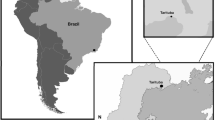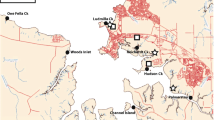Abstract
Surface inland and coastal waters in Ireland were surveyed for the human waterborne enteropathogens; Cryptosporidium parvum, Giardia lamblia, Encephalitozoon intestinalis, Encephalitozoon hellem, and Enterocytozoon bieneusi by utilizing bivalve mussel species, i.e., Mytilus edulis (blue mussel), Anodonta anatina (duck ‘mussel’, actually a unionid clam), and the invasive Dreissena polymorpha (zebra mussel) as biomonitors at twelve sites located in three Irish river-basin districts with various water-quality pressures. Biomolecular techniques were utilized to assess the presence and concentration of these pathogens. At least one pathogen species was detected in shellfish at each site. Cryptosporidium, implicated in several recent Irish gastrointestinal epidemics, was recorded at all sites subjected to agricultural runoff and at one sewage discharge site, linking source-track directly to human and animal fecal wastes. G. lamblia was present at eleven of the twelve sites in a range of concentrations. A coastal bay with raw urban sewage discharge was 100% positive for all analyzed enteropathogens. Overall, the results demonstrate long-term human enteropathogen contamination of Irish waters with consequent public-health risk factors for drinking-water abstraction and water-based activities.



Similar content being viewed by others
References
Beach MJ (2008) Waterborne: recreational water. In: Fayer R Xiao L (ed) Cryptosporidium and cryptosporidiosis. IWA, CRC, Florida, pp 335–370
Chalmers RM, Sturdee AP, Mellors P, Nicholson V, Lawlor F, Kenny F, Timpson P (1997) Cryptosporidium parvum in environmental samples in the Sligo area, Republic of Ireland: a preliminary report. Lett Appl Microbiol 25:380–384
Cotte L, Rabodonirina M, Chapuis F, Bailly F, Bissuel F, Raynal C, Gelas P, Persat F, Piens M, Trepo C (1999) Waterborne outbreak of intestinal microsporidiosis in persons with and without human immunodeficiency virus infection. J Infect Dis 180:2003–2008
Council of the European Communities, 2000. Directive 2000/60/EC of the European parliament and of the council of 23 October 2000 establishing a framework for community action in the field of water policy. Official Journal of the European Communities No L 327. 71 pp
Dorsch MR, Veal DA (2001) Oligonucleotide probes for specific detection of Giardia lamblia cysts by fluorescent in situ hybridization. J Appl Microbiol 90:836–842
EPA (2004) European communities (drinking water) regulations, 2000 (S. I. 439 of 2000) a handbook on implementation for sanitary authorities. Wexford, Ireland
EPA (2007) Urban wastewater discharges in Ireland for population equivalents greater than 500 persons. A report for the years 2004 and 2005. Wexford, Ireland
Fournier S, Liguory O, Santillana-Hayat M, Guillot E, Sarfari C, Dumoutier N, Molina J, Derouin F (2000) Detection of microsporidia in surface water; a one-year follow-up study. FEMS Immunol Med Microbiol 29:95–100
Graczyk TK, Cranfield MR (1996) Assessment of the conventional detection of fecal Cryptosporidium serpentis oocysts of subclinically infected captive snakes. Vet Res 27:185–192
Graczyk TK, Fayer R, Cranfield MR, Conn DB (1998) Recovery of waterborne Cryptosporidium parvum oocysts by freshwater benthic clams (Corbicula fluminea). Appl Environ Microbiol 64:427–430
Graczyk TK, Thompson RCA, Fayer R, Adams P, Morgan UM, Lewis EJ (1999) Giardia duodenalis of genotype a recovered from clams in the Chesapeake Bay subestuary, Rhode River. Am J Trop Med Hyg 61:526–529
Graczyk TK, Marcogliese DJ, deLafontaine Y, DaSilva AJ, Mhangami-Ruwende B, Pieniazek NJ (2001) Cryptosporidium parvum oocysts in zebra mussels (Dreissena polymorpha): evidence from the St. Lawrence River. Parasitol Res 87:231–234
Graczyk TK, Conn DB, Marcogliese DJ, Graczyk H, deLafontaine Y (2003) Accumulation of human waterborne parasites by zebra mussels (Dreissena polymorpha) and Asian freshwater clams (Corbicula fluminea). Parasitol Res 89:107–111
Graczyk TK, Conn DB, Lucy F, Minchin D, Tamang L, Moura LNS, DaSilva AJ (2004) Human waterborne parasites in zebra mussels (Dreissena polymorpha) from the Shannon river drainage area, Ireland. Parasitol Res 93:385–391
Graczyk TK, Lucy FE, Tamang L, Miraflor A (2007) Human enteropathogen load in activated sewage sludge and corresponding sewage sludge-end products. Appl Environ Microbiol 73:2013–2015
Graczyk TK, Majewska AC, Schwab KJ (2008) The role of aquatic birds in dissemination of human waterborne enteropathogens. Trends Parasitol 24:55–59
Hester FD, Linquist HDA, Bobst AM, Schaffer FW (2000) Fluorescent in situ detection of Encephalitozoon hellem spores with a 6-carboxyfluorescein-labeled ribosomal RNA-targeted oligonucleotide probe. J Eukaryot Microbiol 47:299–308
Hutchison ML, Walters LD, Moore A, Avery SM (2005) Declines of zoonotic agent in liquid livestock wastes stored in batches on-farm. J Appl Microbiol 99:58–65
Jenkins MC, Trout J, Abrahamsen MS, Higgins J, Fayer R (2000) Estimating viability of Cryptosporidium parvum oocysts using reverse transcriptase-polymerase chain reaction (RT-PCR) directed at mRNA encoding amyloglucosidase. J Microbiol Methods 34:97–106
Karanis P, Kourenti C, Smith H (2007) Waterborne transmission of protozoan parasites: a worldwide review of outbreaks and lessons learnt. J Water Health 5:1–38
Lowery CJ, Moore JE, Millar BC, McCorry KAJ, Xu J, Rooney PJ, Dooley JSG (2001) Occurrence and genetic genotyping of Cryptosporidium spp. in surface waters in Northern Ireland. J Appl Microbiol 91:774–779
Lucy F (2006) Early life stages of Dreissena polymorpha (zebra mussel): the importance of long-term datasets in invasion ecology. Aquatic Invasions 1:171–182
Lucy F, Sullivan M, Minchin D (2005) Nutrient levels and the zebra mussel population in Lough Key. ERTDI Report Series No. 34. EPA, Wexford. http://www.epa.ie/EnvironmentResearch/ReportsOutput/FileUpload,8806,en.pdf
MacAnulty JM, Keene WE, Leland DE, Hoesly F, Hinds B, Stevens G (2000) Contaminated drinking water in one town manifesting as an outbreak of cryptosporidiosis in another. Epidemiol Infect 125:79–86
Minchin D, Lucy F, Sullivan M, (2002) Monitoring of zebra mussels in the Shannon–Boyle navigation, other navigable regions and principal Irish lakes, 2000 and 2001. Published Report. Marine Environment and Health Series, No. 5. Marine Institute, Dublin
Minchin D, Lucy F, Sullivan M (2006) Ireland: a new frontier for the zebra mussel Dreissena polymorpha (Pallas). Oceanol Hydrobiol Stud 34:19–30
Pelly H, Cormican M, O’Donovan D, Chalmers RH, Hanahoe B, Cloughley R, McKeowan, P, Corbett-Feeney G (2007) A large outbreak of cryptosporidiosis in western Ireland linked to public water supply: a preliminary report. Euro Surveill 12(5):E070503.3 http://www.eurosurveillance.org/ew/2007/070503.asp#3
Pollock KGJ, Young D, Smith HV, Ramsay CN (2008) Cryptosporidiosis and filtration of water from Loch Lomond, Scotland. Emerg Infect Dis 14:115–119
Reynolds JD (1998) Ireland’s Freshwaters. Published Report for Societas Internationalis Limnologiae (SIL) International Association of Theoretical and Applied Limnology XXVII Congress, Dublin, Ireland
Rimhanen-Finne R, Vuorinen A, Marmo S, Malmberg S, Hanninen ML (2004) Comparative analysis of Cryptosporidium, Giardia and indicator bacteria during sewage sludge hygienization in various composting processes. Lett Appl Microbiol 38:301–305
Skerrett HE, Holland CV (2000) The occurrence of Cryptosporidium in environmental waters in the greater Dublin area. Water Res 34:3755–3760
Tamburrini A, Pozio E (1999) Long term survival of Cryptosporidium parvum oocysts in seawater and in experimentally infected mussels (Mytilus galloprovincialis). Int J Parasitol 29:711–715
Thompson RC, Reynoldson JA, Mendis AH (1993) Giardia and giardiasis. Adv Parasitol 32:71–160
Tzipori S, Ward H (2002) Cryptosporidiosis: biology, pathogenesis and disease. Microb Dis 4:1047–1058
Vesey G, Ashbolt N, Fricker EJ, Deere D, William KL, Veal DA, Dorsch M (1998) The use of ribosomal RNA targeted oligonucleotide probe for fluorescent labelling of viable Cryptosporidium parvum oocysts. J Appl Microbiol 85:429–440
Wolfe MS (1992) Giardiasis. Clin Microbiol Rev 5:93–100
Zintl A, Mulcahy G, de Waal T, de Waele V, Byrne C, Clyne M, Holden N, Fanning S (2006) An Irish perspective on Cryptosporidium. Irish Vet Journal 59:442–447
Zotin AA, Ozernyuk ND (2004) Growth characteristics of the common mussel (Mytilus edulis) from the White Sea. Biol Bull 31:377–381
Acknowledgments
We acknowledge Owen Kieran, Moore Marine Services and Michael Duggan, West Coast Diving for providing molluscan shellfish samples. The OECD provided funding for this research under the co-operative research program (Grant AGR/PR(2007)1 to F.E. Lucy). The study was also supported by the Fulbright Senior Specialist Fellowship (grant no. 2225 to T. K. Graczyk), and the School of Science, Institute of Technology, Sligo, Ireland. D. Minchin received support from the European Union 6th Framework project ALARM (GOCE-CT-2003-506675).
Author information
Authors and Affiliations
Corresponding author
Rights and permissions
About this article
Cite this article
Lucy, F.E., Graczyk, T.K., Tamang, L. et al. Biomonitoring of surface and coastal water for Cryptosporidium, Giardia, and human-virulent microsporidia using molluscan shellfish. Parasitol Res 103, 1369–1375 (2008). https://doi.org/10.1007/s00436-008-1143-9
Received:
Accepted:
Published:
Issue Date:
DOI: https://doi.org/10.1007/s00436-008-1143-9




